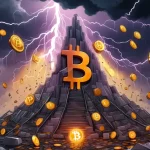Ethereum to $7,000 by 2025: Top Altcoins LILPEPE, XRP, SOL to Watch for Bull Run

Ethereum to $7,000 by 2025: Top 3 Altcoins to Watch for the Next Bull Run
Ethereum (ETH) is making waves with bold predictions of hitting $7,000 by 2025, spurred by a surge of institutional interest and technical upgrades. While Ethereum steals the spotlight, three altcoins—Little Pepe (LILPEPE), Ripple (XRP), and Solana (SOL)—are catching attention as potential contenders for massive gains in the upcoming market cycle. Let’s unpack the hype, the risks, and the realistic outlook for these players in the crypto space.
- Ethereum’s Bold Target: A projected $7,000 price by 2025, driven by institutional capital and scalability improvements.
- Altcoin Contenders: Little Pepe, XRP, and Solana bring unique angles—from meme coin innovation to enterprise solutions.
- Market Dynamics: A potential altcoin rally tied to Bitcoin’s trajectory could amplify opportunities and risks alike.
Before diving into the specifics, it’s worth noting why we’re even looking beyond Bitcoin (BTC), the undisputed king of decentralization and store-of-value. As champions of a decentralized future, we believe Bitcoin remains the bedrock of this financial revolution. But altcoins, for all their flaws, often serve as experimental sandboxes—pushing boundaries and filling niches that Bitcoin doesn’t (and perhaps shouldn’t) touch. With Ethereum leading the charge, let’s explore what’s fueling its ambitious outlook and whether these three altcoins deserve a spot in the conversation.
Ethereum’s $7,000 Dream: Institutional Fuel and Scalability Wins
Ethereum, the second-largest cryptocurrency by market cap, has cemented its place as the backbone of decentralized finance (DeFi) and smart contract innovation. For the unversed, smart contracts are self-executing agreements coded on the blockchain, enabling everything from lending platforms to digital collectibles known as non-fungible tokens (NFTs). With over $60 billion locked in DeFi protocols on Ethereum, it’s no surprise that analysts are eyeing a staggering $7,000 price tag by 2025. This isn’t just blind optimism—it’s tied to real developments. Spot Ethereum exchange-traded funds (ETFs), which allow traditional investors to gain exposure without holding the asset directly, are gaining traction with filings from giants like BlackRock. Tokenized treasury products—think digitized versions of U.S. bonds tradeable on-chain—are also bridging traditional finance (TradFi) with blockchain, pulling in big money.
Then there’s the tech side. Upgrades like the Dencun update earlier this year slashed transaction costs on Ethereum’s Layer-2 solutions—secondary networks built atop the main blockchain to boost speed and affordability. Imagine a congested highway getting express lanes; that’s Layer-2 in a nutshell. Lower fees and faster processing make Ethereum more appealing for developers and users alike. But let’s pump the brakes on the hype train. Regulatory hurdles, like the U.S. Securities and Exchange Commission’s (SEC) ongoing scrutiny of staking services (where users lock up ETH to earn rewards), could dampen institutional enthusiasm. Plus, competition from other Layer-1 blockchains isn’t trivial. If macroeconomic conditions—say, rising interest rates—tighten, that ambitious Ethereum price target of $7,000 by 2025 might look more like a pipe dream than a milestone. Still, if Bitcoin cracks $100,000 as some predict, Ethereum could ride that wave and lift the broader altcoin market with it.
Little Pepe (LILPEPE): Meme Coin Circus or Genuine Innovation?
First on our altcoin list is Little Pepe (LILPEPE), a meme coin that’s trying to be more than just another Dogecoin clone. Unlike the endless parade of joke tokens that crash faster than a cheap drone, LILPEPE claims to offer utility with a dedicated Layer-2 blockchain designed specifically for meme tokens. The idea? Solve pain points like Ethereum’s high gas fees—those pesky transaction costs that can eat up profits on small trades—by providing a faster, cheaper environment for meme coin trading. Currently in Stage 3 of its presale at $0.0012 per token, the project has raised over $3 million, with nearly 96% of tokens snatched up, as detailed in their presale milestone update. The price is slated to tick up to $0.0013 soon, and a $777,000 giveaway (split among 10 winners at $77,000 each in $LILPEPE tokens) is stoking community fervor. Plans for listings on two top-tier centralized exchanges are also in the works, though details remain frustratingly vague.
Now, let’s get real. Meme coins are the Wild West of crypto—volatility is their middle name, and rug pulls (where developers vanish with investor funds) are all too common. LILPEPE’s Layer-2 angle sounds intriguing, but is it a genuine niche or just slick marketing? The lack of transparency on the team behind it and the specifics of those exchange listings raises red flags. Historical context doesn’t help; countless meme coins have flopped after presale hype. Even their own fine print warns of a potential total loss of capital. If they deliver on the tech, LILPEPE could tap into the cultural obsession with meme trading while solving real blockchain bottlenecks. But for now, this is a high-stakes gamble—more circus act than sure bet. Invest only what you’re willing to flush down the toilet.
Ripple (XRP): Back from Regulatory Hell with Enterprise Muscle
Ripple’s XRP, a veteran in the crypto arena, is clawing its way back into relevance after years of regulatory drama. Trading above $2.19, some analysts are tossing around price targets of $3.00 to $5.00, and for once, it’s not pure fantasy. XRP runs on the XRP Ledger (XRPL), a blockchain tailored for lightning-fast cross-border payments and enterprise applications. Since 2020, Ripple has been locked in a brutal lawsuit with the U.S. SEC over whether XRP qualifies as a security—a label that would slap it with heavy oversight. A 2023 court ruling that XRP isn’t a security in secondary market sales was a game-changer, restoring investor confidence. Spot XRP ETFs in Canada and improving clarity in the U.S., as discussed in recent XRP regulatory updates, are adding fuel, though full regulatory peace remains elusive.
On the tech front, XRPL’s version 2.5.0 update brings features like TokenEscrow—think of it as a safe deposit box for digital assets, releasing them only when conditions are met—and permissioned decentralized exchange (DEX) integrations, enabling secure, controlled trading hubs. This makes XRPL a hotbed for stablecoins and tokenized real-world assets (RWAs), which are physical or financial assets like real estate or Treasuries digitized for blockchain trading. Ripple’s partnership with Ondo Finance, launching tokenized U.S. Treasuries (OUSG) on XRPL with $30 million in committed value, is a prime example, as highlighted in their recent collaboration announcement. Markus Infanger, SVP of RippleX, put it bluntly:
“Ondo’s OUSG going live on the XRPL demonstrates that tokenized finance is no longer theoretical, it’s maturing in real markets.”
Ian De Bode, Chief Strategy Officer at Ondo Finance, added that XRPL broadens access to high-quality on-chain financial instruments, with Ripple’s stablecoin RLUSD serving as a settlement option. Toss in collaborations like Japan’s Web3 Salon, and XRP is shaping up as a bridge between TradFi and DeFi. But here’s the rub: Ripple’s centralized control over XRPL irks decentralization purists. Bitcoin maximalists might argue it’s more bank than blockchain. Still, for enterprise-grade finance, XRP’s fundamentals are aligning for a serious comeback—just don’t expect it to embody crypto’s rebel spirit.
Solana (SOL): Speed Demon with a Shaky Track Record
Solana (SOL) rounds out our trio, often billed as Ethereum’s top rival. Trading around $145 with analyst targets stretching to $250–$300, its appeal is raw performance. Solana boasts transaction speeds of up to 65,000 transactions per second (TPS), dwarfing Ethereum’s 15–30 TPS before advanced scaling like sharding (splitting the blockchain into smaller, manageable pieces for efficiency). Fees? Pennies compared to Ethereum’s occasional dollar-plus costs. It’s no wonder Solana leads in developer activity—think GitHub commits, smart contract deployments, and token launches. It’s a hub for DeFi platforms like Raydium, where memecoin trading runs wild, and gaming projects like Star Atlas, a play-to-earn space epic. NFT marketplaces also thrive here, showcasing Solana’s retail and cultural pull. Institutional interest is growing too, with whispers of potential ETFs, though nothing’s confirmed.
But Solana isn’t flawless. Network outages, like the infamous 17-hour downtime in 2021 and sporadic hiccups since, have critics questioning its reliability. Is it a sprinter with shin splints, prone to collapse under pressure? Developers love the speed, but stability matters just as much for long-term adoption. Compared to Ethereum’s battle-tested resilience, Solana still has proving to do, as explored in discussions on Solana’s competitive edge over Ethereum. That said, its ecosystem growth—especially in niches like gaming and NFTs—makes it a compelling bet for scalable blockchain innovation. If it irons out the kinks, Solana could carve a permanent spot as a go-to platform. Until then, it’s a high-reward play with glaring risks.
Bitcoin Maximalism vs. Altcoin Experimentation
Let’s take a step back. As Bitcoin enthusiasts, we can’t ignore that BTC remains the gold standard—unmatched in security, decentralization, and its role as a hedge against inflation and fiat decay. No altcoin, no matter how shiny, can replicate its network effect or battle-hardened resilience. Ethereum’s smart contract dominance and altcoin experiments like LILPEPE, XRP, and Solana often sacrifice trustlessness for speed or utility, straying from crypto’s core ethos. Yet, in the spirit of effective accelerationism—pushing tech forward, warts and all—these projects drive disruption. They test new ideas, reach untapped audiences, and sometimes fail spectacularly, but that’s how progress happens. Bitcoin doesn’t need to be everything to everyone; altcoins can fill gaps, even if they’re often overblown distractions.
Market Context: Catalysts and Landmines
Beyond individual projects, broader forces could make or break this rally. Bitcoin’s potential $100,000 milestone, possibly tied to the next halving (which cuts miner rewards and historically sparks price surges), might drag Ethereum and altcoins upward. Regulatory shifts—like clearer U.S. guidelines or harsher crackdowns—loom large. Macro factors, from interest rate hikes to inflation fears, could choke liquidity and derail even the most promising tokens. Ethereum’s institutional wave might spark an altcoin frenzy, with insights shared in community forums like Ethereum price discussions for 2025, but scams and market froth are inevitable traps. Sorting signal from noise will be the ultimate challenge for anyone chasing gains in this space.
Key Takeaways and Burning Questions
- What’s behind Ethereum’s $7,000 price prediction for 2025?
Institutional inflows through spot ETFs, tokenized financial products, and scalability upgrades like Dencun are the main catalysts, though regulatory and competitive risks could slow the climb. - Is Little Pepe (LILPEPE) a worthwhile speculative play?
Its presale traction ($3 million raised) and Layer-2 focus for meme coins are novel, but extreme volatility and transparency concerns make it a risky bet—only for the bold or reckless. - How is Ripple (XRP) rebuilding its case for relevance?
Regulatory wins, XRPL enhancements for tokenized assets, and partnerships like Ondo Finance are key, though its centralized nature clashes with decentralization ideals. - Why is Solana (SOL) seen as Ethereum’s biggest rival?
Blazing speed, dirt-cheap fees, and developer momentum in DeFi and NFTs give it an edge, but network outages cast doubt on its reliability for the long haul. - Should investors look beyond Bitcoin and Ethereum?
Altcoins offer niche innovation and high-upside potential, but balance is critical—Bitcoin’s stability and ethos should anchor any portfolio amid speculative plays.
Navigating this crypto bull cycle demands a clear head. Ethereum’s projected surge could indeed ignite broader market gains, but don’t swallow every price prediction whole—most are just guesswork dressed as gospel. Scammers and hype merchants thrive in these waters, so due diligence isn’t optional; it’s survival. We’re all for accelerating a decentralized, privacy-first future, but that means calling out nonsense and focusing on what truly moves the needle. As the market heats up, the real test will be separating transformative tech from fleeting fads.



